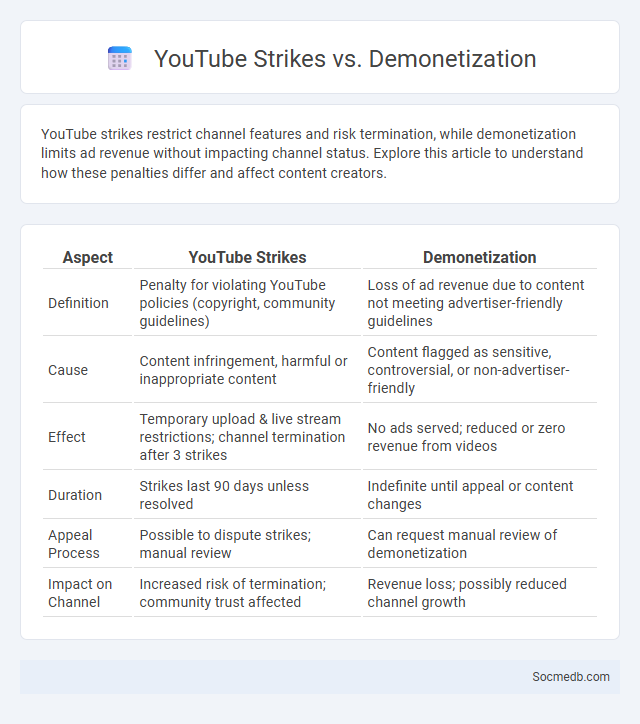
Photo illustration: YouTube Strikes vs Demonetization
YouTube strikes restrict channel features and risk termination, while demonetization limits ad revenue without impacting channel status. Explore this article to understand how these penalties differ and affect content creators.
Table of Comparison
| Aspect | YouTube Strikes | Demonetization |
|---|---|---|
| Definition | Penalty for violating YouTube policies (copyright, community guidelines) | Loss of ad revenue due to content not meeting advertiser-friendly guidelines |
| Cause | Content infringement, harmful or inappropriate content | Content flagged as sensitive, controversial, or non-advertiser-friendly |
| Effect | Temporary upload & live stream restrictions; channel termination after 3 strikes | No ads served; reduced or zero revenue from videos |
| Duration | Strikes last 90 days unless resolved | Indefinite until appeal or content changes |
| Appeal Process | Possible to dispute strikes; manual review | Can request manual review of demonetization |
| Impact on Channel | Increased risk of termination; community trust affected | Revenue loss; possibly reduced channel growth |
Understanding YouTube Strikes: Policies and Consequences
YouTube strikes result from violations of the platform's Community Guidelines, including copyright infringement, hate speech, and harmful content. Accumulating multiple strikes can lead to penalties such as video removal, loss of monetization, and account termination. Understanding YouTube's strike system helps creators maintain compliance and protect their channels from suspension or bans.
What Triggers Demonetization on YouTube?
YouTube demonetization is primarily triggered by content that violates the platform's Community Guidelines or Advertiser-Friendly Content Guidelines, such as hate speech, violence, adult content, or misinformation. Videos that contain copyrighted material without proper authorization or misleading metadata can also lead to demonetization. Understanding these triggers helps you create compliant content and maintain your channel's revenue stream effectively.
Demonetization vs Content Removal: Key Differences
Demonetization restricts Your ability to earn revenue from social media content without deleting the post, while content removal completely eliminates the content from the platform. Demonetization often targets videos or posts that violate monetization policies but remain visible to users, whereas content removal enforces stricter compliance by taking down material that breaches community guidelines. Understanding these key differences helps you navigate platform regulations effectively to maintain your online presence.
YouTube Strikes: Types and Escalation Process
YouTube strikes consist of three main types: Community Guidelines strikes, Copyright strikes, and Advertising strikes, each impacting your channel differently in terms of restrictions and penalties. The escalation process begins with a first strike warning, followed by temporary feature limitations with the second strike, and culminates in channel termination upon receiving a third strike within a 90-day period. Understanding these escalation steps is essential for managing your channel's compliance and avoiding permanent removal from the platform.
The Impact of Demonetization on Creators’ Revenue
Demonetization on social media platforms has significantly affected creators' revenue by reducing ad placements and limiting monetization options, leading to decreased income streams. You may experience challenges in sustaining your content production due to stricter policies and algorithm changes that prioritize certain types of content over others. Understanding platform-specific demonetization rules is essential for optimizing your revenue opportunities and adapting your content strategy effectively.
Demonization: How Controversy Affects YouTube Creators
Demonization significantly impacts YouTube creators by leading to reduced algorithmic favor, which decreases their content's visibility and potential earnings. Controversy often triggers mass reporting and community backlash, causing creators to face stricter content moderation or channel suspensions. Your channel's reputation and monetization opportunities can suffer drastically when social media platforms prioritize controversy over fair content evaluation.
Navigating Appeals: Reversing Strikes and Demonetization
Navigating appeals for social media strikes and demonetization requires understanding platform-specific policies and providing clear evidence to contest violations. Users must submit detailed requests supporting their compliance with community guidelines or copyright rules to increase chances of reversal. Prompt, well-documented appeals often result in restored account functionality and monetization privileges.
Protecting Your Channel: Best Practices for Compliance
Ensuring compliance on social media channels requires adhering to platform policies, including content guidelines and data privacy regulations such as GDPR or CCPA. Regularly updating privacy settings, monitoring user interactions for inappropriate content, and obtaining necessary consents before sharing personal data help maintain a secure and trustworthy channel. Implementing these best practices reduces risks of account suspension, legal penalties, and enhances audience trust.
YouTube’s Algorithmic Approach to Flagging Content
YouTube's algorithm employs machine learning models to identify and flag content that violates community guidelines, using a combination of metadata analysis, user reports, and automated detection of harmful or misleading videos. The system evaluates factors such as video titles, descriptions, thumbnails, and viewer behavior patterns to assess compliance and prioritize content for human review. Continuous updates to the algorithm enhance its accuracy in moderating content while balancing creator freedom and platform safety.
Community Response: Creators’ Experiences and Coping Strategies
Creators on social media often encounter varied community responses, ranging from supportive engagement to negative criticism, impacting their mental health and content output. Effective coping strategies include setting boundaries through content moderation, fostering positive interactions by engaging with supportive followers, and utilizing platform tools to filter harmful comments. Understanding these dynamics helps creators maintain resilience and authenticity in the digital landscape.
 socmedb.com
socmedb.com